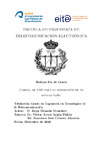Please use this identifier to cite or link to this item:
https://accedacris.ulpgc.es/handle/10553/76838
| Title: | Cabezal de VHF para la integración de un módulo LoRa | Authors: | Monzón Monedero, Jorge | Director: | Araña Pulido, Víctor Alexis Cabrera Almeida, Francisco José |
UNESCO Clasification: | 3325 Tecnología de las telecomunicaciones | Issue Date: | 2020 | Abstract: | El aumento de las temperaturas trae consigo inherentemente el comienzo de la temporada de incendios forestales. Las consecuencias que deja a su paso son el retroceso económico y social de las poblaciones cercanas al incendio, as como la pérdida de la biodiversidad del entorno afectado. En la lucha contra el fuego, es importante que a los operarios se les proporcione información a tiempo real del estado de las líneas de fuego para que se pueda generar una respuesta rápida y e caz. En ese sentido, el proyecto Red GesFoGO plantea el diseño de una red integral de unidades ligeras móviles dotadas de sensores para obtener datos del avance del incendio, y de un sistema de evacuación que permita derivar los datos a la unidad que tome las decisiones.
En este trabajo se ha abordado el diseño parcial del sistema que permite evacuar los datos captados por los sensores. Dado que en el entorno en el que va a funcionar el sistema la radiofrecuencia se ve muy perjudicada, ha sido necesario el diseño de un circuito que permita adaptar la radiofrecuencia a unas condiciones en las que el entorno no afecte tanto. Dadas las especi ficaciones que debe cumplir el circuito, se realizó el diseño, es decir, la elección de topología, la determinación de los parámetros internos y la elección de los componentes.
Una vez de nido el diseño se procedido a la implementación del circuito, primero generando el modelo en software y, naturalmente, construyéndolo. Tras con figurar los componentes del circuito, se diseñaron las medidas que se debían tomar para validar su funcionamiento y se procedió a llevarlas a cabo. El resultado final es un primer prototipo que aún no es funcional pero que sirve como punto de partida para ir realizando mejoras y lograr el desarrollo de un sistema de evacuación totalmente operativo. The rise of the temperature brings with it the start point of the forest res. This kind of disaster implies a set of consequences related to the society and economy of the populations nearby the re, and a serious damage to the biodiversity of the environment. In order to be fast and e ective against the re, the people involved in the extintion of the ames need to receive real time information about the status and the development of the forest re. Due to those requirements, Red GesFoGO proposes the design and development of a network conformed by lightweight mobile units equipped with sensors in order to get data about the status and evolution of the ames. Moreover those units must be able to communicate that data to the people involved into the decision making. A part of the system responsible of the communications of the units is the focus of this nal degree project. Due to the perturbations in icted by the rural environment to the radiofrequency, the design of a subsystem capable of minimizing the negative e ects caused by the environment takes on special importance and becomes a necessity. The subsystem was designed based on the speci cations given, which implies to choose a topology, to determinate the inner characteristics and, nally, to choose the components which de nes the circuit. After de ning the design of the circuit, the implementation was done. First of all, the circuit was model by using a software and it was built afterward. Before performing the measurements on the circuit to validated it, the con gurations of certain chips was set up. The rst prototype obtained is not functional yet, but the beginning of the improvements of the design to get a fully operative system. |
Department: | Departamento de Señales Y Comunicaciones | Faculty: | Escuela de Ingeniería de Telecomunicación y Electrónica | Degree: | Grado en Ingeniería en Tecnologías de la Telecomunicación | URI: | https://accedacris.ulpgc.es/handle/10553/76838 |
| Appears in Collections: | Trabajo final de grado |
En el caso de que no encuentre el documento puede ser debido a que el centro o las/os autoras/es no autorizan su publicación. Si tiene verdadero interés en el contenido del mismo, puede dirigirse al director/a o directores/as del trabajo cuyos datos encontrará más arriba.
Show full item recordPage view(s)
217
checked on Jun 8, 2025
Download(s)
312
checked on Jun 8, 2025
Google ScholarTM
Check
Share
Export metadata
Items in accedaCRIS are protected by copyright, with all rights reserved, unless otherwise indicated.
